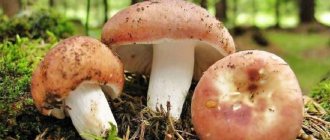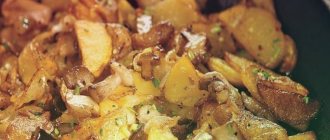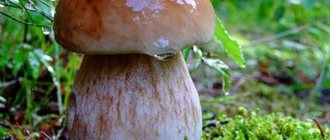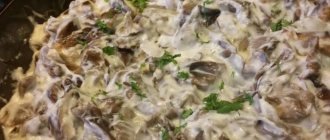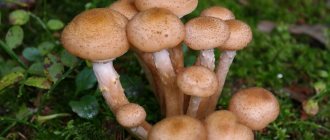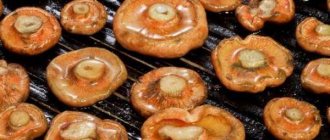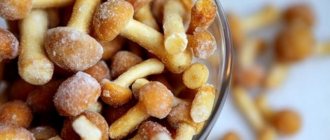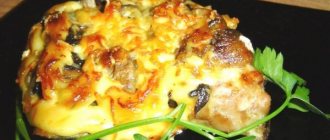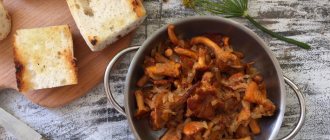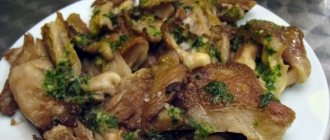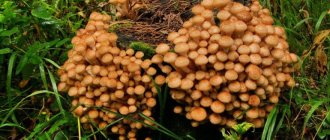Our menu again includes a small selection of recipes.
This time I suggest frying russula mushrooms. Russula is a common type of mushroom in our latitudes. They are beneficial for the body because they contain B vitamins, as well as E and C. They contain a sufficient amount of potassium, magnesium, iron, lecithin and various amino acids. The product is low-calorie, 100 g contains only 21 kcal, so they are suitable for people who adhere to dietary and proper nutrition. In cooking, russula is prepared by boiling, frying, stewing, pickling and drying. A characteristic feature of the mushroom is that it has a pronounced bitter taste. Attractive appearance, dark cap and light cylinder-shaped stem, as well as dense flesh make them an ideal component of salads. But russula is also tasty together with fried potatoes, and salted mushrooms have recently been considered a delicacy.
Find out when and how to collect russula in central Russia.
Characteristic
The description of the species includes several distinctive features that distinguish it from others:
- a small round fleshy cap with a diameter of 5 to 12 cm; in an adult mushroom it is flat;
- the border is wavy, scarred, the color range is varied - gray, yellow, brown or cherry;
- under the cap there is a spore-bearing layer - the hymenophore, represented by large plates of white or yellow hue;
- the fruiting body is planted on a thick, erect stalk, slightly curved at the base: in young specimens the color is snow-white, the taste is insipid, in older specimens it is dark gray in tone with a fruity aroma.
This mushroom can be found in mixed and coniferous forests, where the soil has a high calcium content.
How to store it correctly
It is recommended to store salted russula in jars for the winter in a cool room or refrigerator. The pantry is not suitable for this purpose. If the preservation is placed in a basement or cellar, it is necessary to monitor the air temperature in the storage. It should not rise above +8°C and fall below 0°C.
The twists should be constantly monitored. If the brine has evaporated from a jar covered with a nylon lid and the caps are above the liquid, you can replenish the loss of moisture by adding boiled water.
Collection rules
The best time to collect russula is early morning. Peak fruiting occurs in August-September.
For this process, the mushroom picker needs to acquire:
- light, warm and comfortable clothing;
- wicker basket with thick walls;
- a sharp knife for high-quality cutting of fruiting bodies;
- a stick with which you can push aside the grass in search of mushrooms.
It is worth collecting young mushrooms - they have a delicate taste and rich aroma.
The best way is to carefully cut the stem at the very bottom so that part of it remains in the soil - then it will be able to produce new fruiting bodies.
Before placing in the basket, each mushroom is cleaned of soil and other forest debris.
When collecting, it is necessary to carefully examine the appearance, since some varieties have many similarities with the pale grebe.
Preparing mushrooms for pickling
The processing time and the best option for canning or pickling depend on the type of russula. Hot salting is not suitable for all representatives of the lamellar genus. This cooking method is suitable for mushrooms that are not very bitter, but are soaked for 12 hours.
All types of russula can be pickled using the cold method, but they are left in water for a day, changing the liquid 6 times. It is recommended to resort to dry pickling if the mushrooms have not released juice and there is no burning aftertaste or bitterness. These russulas are soaked for no more than 5 hours, and this is not at all necessary.
Lamellar representatives of the forest break and are damaged when cleared of needles, sand, and leaves. Having collected the mushrooms in a basket or enamel bucket, place them in a basin or bowl filled with warm water.
After 15 minutes, remove any remaining pine needles or soil from the russula with a toothbrush. After this, they are washed under the tap and soaked.
Varieties
To learn how to distinguish edible Bruises from their doubles - false mushrooms, you need to familiarize yourself with their detailed description.
Edible
The podgrudok is white (russula is excellent or pleasant). The young fruiting body is characterized by a snow-white cap, sometimes covered with light yellow spots, and has a convex, funnel-shaped shape.
The leg is of small height, narrowed towards the bottom, snow-white or brown. Mushroom areas are mixed and coniferous forests. The collection is carried out in summer and autumn.
Russula yellow. Young specimens have a spherical, yellowish hat; later it takes on a flat shape. The diameter, depending on age, is 5-10 cm. The skin along the edge can be easily torn off. The leg is white. The plates are first snow-white, then light yellow, and grayish in older ones. The pulp is white, turns gray when cut, then turns black.
An edible sweetish mushroom found in the summer-autumn period. Habitat: birch and pine forests.
Russula blue (azure). It grows mainly in coniferous forests, mainly in spruce forests, where it forms entire nests. You can identify it by its white stem 3-5 cm high and a bluish cap with a circumference of 3-10 cm. Young mushrooms have a solid stem inside. but in older ones it is already hollow or even multi-chambered.
Greenish. In appearance it is not particularly attractive, but of all the varieties of russula, this mushroom is the most delicious. It got its name from the color of the cap - green or gray-green, with a diameter of 10 cm. The skin can be easily removed to almost half the cap. Location: coniferous and deciduous forests.
The leg is white with dense flesh.
Care should be taken when collecting as this mushroom is very similar to the toadstool.
Inedible
Birch russula. It prefers to grow in the root part of birches, appears in early summer and bears fruit until the end of autumn. The skin is easily removed from the surface of the cap. The color is very diverse, but most often it is lilac-pink with a central yellowish spot. The leg is wrinkled, often hollow, and gets wet during rainy weather.
Russula is blood red. Found mainly in pine forests. The cap has a flat-convex shape, a rich scarlet color, a circumference of 6-7 cm. Peak fruiting occurs in July-September. Not used as food due to bitter taste. If eaten raw, it can cause poisoning and problems with the gastrointestinal tract.
Russula pink. The cap is pink in color (can often range from red to dark pink), funnel-shaped, and later acquires a flat-round shape. These mushrooms are bitter.
They grow in deciduous and coniferous forests; peak fruiting occurs at the beginning of July and until the end of September.
How to cook row mushrooms for the winter. How to salt rows at home
Rowers are mushrooms that are often found in the forest, but are little known to beginning mushroom pickers. Experienced connoisseurs love to salt the rows at home for the winter.
Like the rows, they are salted, pickled, fried, and boiled. It’s easy to pickle them if you know the cooking details. Then they turn out incredibly tasty and aromatic. You can always add something of your own to any of the recipes.
Salted rows are a wonderful appetizer for the table. They are sold in stores, but I recommend canning them yourself. Salting these mushrooms is not difficult if you follow some rules to make the dish delicious. I offer several proven recipes. We also have them on our website. Be sure to study it.
Classic recipe for salting rows
Rows are ideal for pickling, and first of all we will consider the classic cooking technology. It involves the use of spices, currant leaves and horseradish, which have a positive effect on taste and aroma.
- Place the peeled, washed and soaked mushrooms in a prepared barrel or other convenient container with the legs facing up. Do everything in layers, not forgetting to sprinkle with salt and spices. Place some dill, horseradish, and currant leaves on the bottom.
Place the rows on top with the caps down, cover with a layer of spices and leaves, and press down with a plate with a weight. As the mass thickens, later add a new portion of rows sprinkled with salt.
Move the container to a cool place. The pickle will be ready in 40 days.
The classic way to prepare salted rows is simple. Of course, it will take a long time before the finished delicacy appears on the table, but the wait is worth it.
How to salt rows for the winter in jars
Rows are salted for the winter in several ways, including hot and cold. Rows salted using the hot method are served within a few days. Cold salting takes longer, but the mushrooms turn out tastier and crispier.
Cold way
Ingredients:
- Rows - 1 kilogram.
- Garlic – 3 cloves.
- Horseradish leaves - 3 leaves.
- Dill - several sprigs.
- Peppercorns – 10 pieces.
- Coarse salt – 50 grams.
How to cook:
- To begin, sort the mushrooms, clean them from dirt and wash them in water several times. Place in a saucepan and add water, boil for two to three minutes and strain.
- Place horseradish leaves into prepared jars. Lay out the rows in layers, sprinkling with salt. Add garlic cloves between layers.
- Having laid the last layer, close the containers with lids. Place in a cool place for a month and a half. Pickles can be stored for up to a year.
Remember, dill and horseradish leaves are used in pickling for a reason. Dill gives flavor, and horseradish adds spiciness and prevents it from souring. Some housewives additionally use cherry leaves, which make the mushrooms crispy and elastic.
Hot way
Ingredients:
- Rows - 1 kilogram.
- Water – 1.5 liters.
- Salt – 75 grams.
- Bay leaf – 3 pieces.
- Black peppercorns – 10 pieces.
- Cloves – 5 pieces.
- Allspice - optional.
Preparation:
- Pour water into a large container and place on fire. Send all the spices there. Boil the liquid over high heat.
- Clean and wash the rows, then place them in boiling water and wait until they boil again. Then reduce the heat and, covering the container with a lid, cook for 45 minutes.
- Place the boiled mushrooms in jars and fill with hot brine. When cool, cover with plastic lids. Place in a cool place for 40 days.
One week is enough for the mushrooms to salt, but the dish will reach its peak taste in a month and a half. Therefore, I advise you to be patient. During this time, you can choose a good side dish for the mushroom appetizer, although it will wear out.
Useful tips
Rowers are incredibly tasty mushrooms, regardless of the cooking method. We have already reviewed step-by-step recipes. Finally, I will share recommendations that will help make the dish perfect.
- Traditionally, row caps are used for pickling. The skin is carefully removed from them, then washed several times. This helps get rid of grains of sand that get stuck between the plates.
- Rows are delicious in any form. They are fried, boiled, pickled and salted. Always soak for at least three days in ice water before cooking.
- Row mushrooms are included in the category of conditionally edible mushrooms and cannot be consumed raw. Heat treatment minimizes the risk of poisoning, so nutritionists advise salting mushrooms using a hot method.
- For those who want to experiment with taste, I advise you to add new ingredients to the container with mushrooms. These can be spices, leaves of fruit and berry trees.
Now you know all the ways to pickle rows at home for the winter. As for serving the dish to the table, everything is simple. Remove the mushrooms from the jar, drain in a colander, rinse with water, place in a salad bowl, add chopped onion and a little vegetable oil. After mixing, the snack is ready. Bon appetit!
Useful qualities
Mushrooms are suitable for dietary nutrition
The description includes low calorie content - only 19 kcal per 100 g. But at the same time, the fruiting bodies are highly nutritious.
Russulas are useful for cleansing the stomach; they have antibacterial properties. They contain a substance - russulin, which promotes the curdling of dairy products, so the mushroom is often used in the preparation of certain types of cheese.
In one of the types of russula (blue), scientists from St. Petersburg discovered the enzyme russulin. Experiments have shown that they can replace rennet used in cheese production. The activity of this compound is very high: 0.5 g of this compound can curdle 100 liters of milk in 30 minutes.
For your information. Natural rennet (rennin, or chemosin), necessary for cheese production, is obtained from the ground stomachs of calves no older than 10 days of age.
The cap and legs contain lecithin - it normalizes cholesterol levels in the blood. The pulp is a source of vitamins PP and B2.
Low-calorie mushrooms can be included in your daily diet menu - they help you lose excess weight.
With regular use, they prevent the development of diseases of the gastrointestinal tract and the appearance of blood clots.
Mushroom pickling. Pickled rows for the winter
Step-by-step recipe with photos
Delicious pickled rows will be an excellent appetizer on the holiday table and will perfectly complement a home-cooked dinner. But we will share how to cook them deliciously in this recipe. Since green mushrooms and subgreens grow almost in the sand itself, washing mushrooms from it is not an easy task. We offer a simple, albeit time-consuming method - soak the mushrooms in salt water several times. The main thing is that the volume of water is several times larger than the mushrooms themselves and from time to time mix gently, trying not to break the mushrooms themselves. To prepare the marinade, you can use your favorite spices; some add garlic and dill seeds, more pepper and less sugar. This is, of course, a matter of taste. I hope you will also like the version of the marinade we have proposed, and the mushrooms will turn out great.
How to cook
Collected mushrooms must be carefully sorted from leaves, twigs and other debris.
Place the mushrooms in a deep saucepan or bucket, add water and rinse thoroughly to remove sand. Then pour fresh water over the mushrooms and pour about 100-150 grams into a bucket. salt, mix gently. Leave the mushrooms in salted water for about half an hour, stirring occasionally. The salt water will cause the plates of the mushrooms to open and all the sand will come out.
You need to repeat the process of soaking mushrooms in salt water several times. Each time, change the water to clean water and add a new portion of salt. It is better to repeat this process 3-4 times until the water from the mushrooms is completely transparent, without sand.
Place clean mushrooms in a large saucepan, cover with cold water and boil for 30 minutes.
All foam that forms must be removed.
Then drain the first broth, drain the mushrooms in a colander and rinse well with running water.
Return the mushrooms to the pan and add fresh water.
Cook the mushrooms a second time for about an hour.
At this time, prepare the brine for pickling the mushrooms. To do this, pour salt, sugar into the water, add pepper, cloves and bay leaf. Boil and simmer the marinade for 10 minutes.
Using a slotted spoon, remove the mushrooms from the pan, discarding the mushroom broth. Divide into half-liter sterilized jars, filling them about three-quarters full (a little more than half the jar).
Pour the hot marinade over the mushrooms.
Then pour 1 tablespoon of 9% vinegar into each jar.
And if necessary, add a little more marinade or boiling water to the very top of the jar.
Roll up the jars with sterile lids, turn them over and wrap them in a warm blanket until they cool completely.
Contraindications
It is easy to confuse an edible mushroom with a false one in appearance, although the latter are bitter, caustic and toxic.
Once ingested, there is a high risk of damage to the gastric and intestinal mucosa. This may cause nausea and vomiting. Therefore, they can be distinguished at least by their bitter taste.
Edible bruise is contraindicated in the following cases:
- for heart diseases;
- the presence of stomach and duodenal ulcers;
- children under 12 years of age;
- period of pregnancy and lactation.
Excessive consumption of russula is prohibited even for people who do not have health problems. The maximum dose per day is no more than 150 g.
Is it possible to salt volushki and russula together?
Many mushrooms get along well in one jar. This applies to boletus, boletus, and different types of milk mushrooms. It is not advisable to combine russula with other mushrooms when salting. The fact is that, compared to tremors, they do not require long cooking. In addition, russula, if not properly processed, can transfer its inherent bitterness to other mushrooms.
Application
Edible russula are very popular in cooking and medicine. They are used to prepare delicious dishes and effective medicines.
Cooking
First, the russula is boiled in salted water: peeled, cut and poured with water so that it completely covers them.
Place on the fire, bring to a boil, skim off the resulting foam. You need to cook for 15 minutes, then add salt and spices. Cook for the same amount of time, remove from heat, strain and the boiled mushrooms can be used to prepare any dish.
Pickling
These mushrooms are very fragile and break quickly, so they are not suitable for drying. But they are readily salted, and the product is not only tasty, but also healthy.
Russulas for pickling need to be properly prepared. And this means:
- All fruiting bodies must be sorted by size and color.
- Throw away any spoiled mushrooms. Attention! Russulas need to be handled very carefully due to their fragility.
- After sorting, the mushrooms must be washed and cleaned: if they are very dirty, they can be soaked for several hours in cold water. Or pour boiling water and after the water cools, catch the mushrooms, which will become stronger.
- Mushrooms must be rinsed with running water.
- It is better to remove the skin from the caps (this will improve the appearance and increase the shelf life of the finished product).
You can pickle it in small jars - 1-2 liters. For cooking you will need 4 tbsp. l. coarse salt per 1 kg of mushrooms. Mushrooms boiled according to the method described above are placed in jars, each layer is sprinkled with salt and any spices. Be sure to add bay leaf - it will give the pickling a good aroma. The workpiece is covered with a nylon lid and placed for a month in a cool and dark place (cellar, basement). After time, it is ready to eat.
They marinate in the same way, only boiled mushrooms are poured with a pre-prepared marinade - 200 ml of vinegar 9% and 100 g of table salt are dissolved in 1 liter of water.
Frying
Fried bruises are very tasty. They are served both separately and as a side dish for fish and meat.
You can cook using different methods, but you need to adhere to a simple rule - the frying time should not exceed 20 minutes, otherwise they will disintegrate and their taste will not be rich.
By the way. Experienced mushroom pickers advise cleaning russulas with bright blue and red caps before frying so that they do not give a bitter aftertaste when cooking and spoil the dish.
What types of russula are suitable for pickling?
Representatives of different varieties of the lamellar genus differ in the color of their caps. In the most delicious mushrooms it has a light green and grayish color, but the pale toadstool has the same shade.
These russulas must be collected extremely carefully.
Red cap mushrooms tend to be bitter, but the bitter taste disappears when soaked in salt water for 3 or 4 hours. If it has a swampy tint, it is better not to take russula - a person will not get poisoned by eating it, but he will not get pleasure either.
Bright red mushrooms that smell like fruit should not be cut off - they contain poison. Russulas with yellowish and pink caps have neither taste nor aroma. There is no need to waste time preparing dishes from these mushrooms.
The bluish or brown color often causes concern, but the blues, as they are called, are prized for their walnut aroma, and dishes made from them are incomparable.
An unusual recipe for fried russula with ham and rice
Until recently, this type of mushroom was considered second-class. There were a lot of them in the forests, and it was difficult to bring them home in their entirety due to their excessive fragility. Nowadays russulas are treated with great respect. Therefore, they began to serve it not only with potatoes, but also with such a noble side dish as rice. At first glance, the dish seems strange, but once you try it, it will definitely become a favorite.
- russula – 400 g;
- tomato - 1 pc.;
- boiled rice - as much as will go in;
- onion – 1 pc.;
- carrots – 1 pc. (small);
- hard cheese - 150 g;
- ham – 130 g;
- seasonings, salt, pepper - to taste;
- vegetable oil – 2 tbsp;
- mayonnaise – 3 tbsp.
Preparation: Prepare the mushrooms for subsequent work with them. Select russulas with large caps intact and separate them from the stem. Rub with your favorite spices, pepper, salt and leave to marinate a little. Finely chop the mushroom stems and onions, and grate the carrots. Fry the vegetables in vegetable oil and combine with boiled rice. Add chopped ham, chopped tomato and grated cheese there.
Mix the whole mass thoroughly until it has a homogeneous consistency, taste it and add salt if necessary. Fill the russula caps with the prepared filling and place a small amount of mayonnaise on top. Fry in vegetable oil for 15 minutes under the lid, and then 10 minutes over medium heat without it. Serve russula with rice and ham as a separate dish, garnished with grated garlic and herbs.
How to quickly pickle russula under pressure
Pressure is just one of the tricks for preparing russula in a quick way.
- To speed up the process, experienced mushroom pickers advise using hot pickling, the recipe for which I introduced at the beginning. But do not put the seasonings at the bottom of the jar, but pour them over the mushrooms. Then, instead of two weeks to receive a ready-made snack, it will take only 4-6 days.
- Another quick version of salting is known, which uses boiled russula. Drain the broth, place the mushrooms in a frying pan in hot oil. Add your favorite seasonings, salt, and pour in a couple of large tablespoons of table vinegar. You can try the snack right away.
Russula pickles are prepared by adding various herbs and seasonings. Traditionally, garlic, several types of pepper, and dill are added. There are unusual additives: juniper, cloves, bird cherry, ginger, tarragon (tarragon), cumin, mint, cilantro, hot chili. A wide variety of greens: horseradish, currants, oak, cherry leaves, rarely, but there are recipes with fern leaves. See one of these unusual options below.
Fried russula: classic recipe
Compound:
- Russula – 500 g
- Onions – 2 pcs.
- Garlic – 5 cloves
- Butter – 50 g
- Lemon juice – 1 tbsp.
- Salt and pepper - to taste
- Greens - to taste
Preparation:
- Peel the onions and garlic. Finely chop the onion and pass the garlic through a press.
- Sauté vegetables in a frying pan with butter.
- Cut the russula into slices, add to the onion and garlic, pour in lemon juice.
- Add salt and pepper to taste, mix well and fry over high heat.
- Serve fried russula with potatoes, pasta or as a separate dish. In addition, they are recommended to be added to salads, soups, and pies.
Recipe for fried russula with potatoes
This method of serving mushrooms can rightly be called classic. For the above recipe, it is better to take young potatoes of a variety that does not boil soft. Russulas can be of any size; they will still need to be cut. The ideal addition to the dish would be a sour cream based sauce.
Ingredients:
- Russula – 300-400 g;
- new potatoes – 500 g;
- onions – 2 pcs.;
- garlic cloves – 5-7 pcs.;
- refined and butter - 2 tbsp each;
- salt, spices - to taste.
